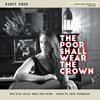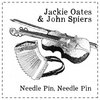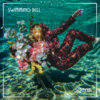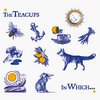Lubber's Hole by She Shanties

Lubber’s Hole: a hole in a square-rigger’s top near the mast through which one may go farther aloft without going over the rim by the futtock shrouds (Merriam-Webster Dictionary).
All songs traditional except where otherwise stated. All songs arranged by She Shanties.
While recording Lubber’s Hole, we believe we have achieved the world record for the most breastmilk expressed during a shanty recording session. If you think we’re wrong, tell it to the Guinness Book of Records.
She Shanties are: Bekka Bojanowski, Cath Tyler, Eilish Ferry-Kennington, Esther Ferry-Kennington, Freyja Boycott-Garnett, Kate Gessey, Rachel Hamer, Ruthie Boycott-Garnett, Ruth Price, Sadie Greenwood, Sally Gall.
Artwork by Bekka Bojanowski.
Recorded, mixed and mastered by Julie Bartley at Cupola Studios, Scotswood, Newcastle Upon Tyne.
1 - Johnny Come Down to Hilo - A song of black origin (Hugill and Doerflinger say “Negro” origin), which was sung at the capstan. We don’t use the racist language that appears in their collected versions but that doesn’t disguise the reference to life on the plantation. We’ve posted some more thoughts about the links between shanties and race on our website.
2 - Old Moke - Learned from Jeff Warner. His tune is based on John Short singing it to Cecil Sharp, but adapted for banjo. There are two kinds of bad language in this song. One is enough to make your ma wash your mouth out. The other is about keeping people down, thinking of them as less than human, and not individually. Pretty much whatever 'moke' came from (USA smoke, Northern Ireland lower class, Australian ass), it was used to make someone be 'other'.
3 - Mingulay Boat Song - An old favourite in the singing and folk communities about returning home to the now long deserted island in the Outer Hebrides. Sung to the rhythm of the boatsmen pulling their oars. Written by Hugh S Robertson in 1938.
4 - Shawneetown - Written by Dillon Bustin, based on a few fragments of lyrics printed in the early 19th Century. He tells us in correspondence that these are his preferred verses. Flatboats, having drifted downstream, were often disassembled at the destination and the lumber repurposed. If returning upstream, this was either by thrusting a pole into the mud or bushwhacking, both of which were knackering.
5 - The Trawling Trade - Written by John Conolly over just two or three days in 1973 with the recording date of Songs from the Stocks fast approaching. With lyrics full of alliteration, wonderful story telling and a great tune, we loved this song the moment we heard it. We’d quite fancy a pint in the dockside pubs with those fishermen newly paid. We assume they are paying.
6 - Twiddles - Alas, what are we to do when the sailors are away? A tale of the adventures of those left on land. Written by Janie Meneely, a firm friend of She Shanties. We first heard it sung by Eight Belles (from Sligo) at Liverpool Shanty Festival.
7 - Essequibo River - Essequibo River is the largest river in Guyana; the King. The skipper commands, the bosun is in charge of the equipment and crew and where we have a King, we need a Queen; the Judy.
8 - The Dreadnought - This foc’sle – or forecastle – shanty would have entertained off-duty sailors with praise of Captain Sam Samuelson and his saucy packet. First recorded in 1883, it tells the story of a famous Western Ocean Steam packet, which made 31 roundtrips from New York to Liverpool between 1853 and 1864.
9 - Mrs McGrath - Not a shanty, but most definitely a song of life on the sea. From the singing of Tommy Makem with The Clancy Brothers circa 1960. A laughing tone and a catchy tune to this anti-war song with an underlying bitterness at the cruelty of war and life at sea.
10 - Bound to Australia - We found this song in Stan Hugill’s shanty bible. It shares a line with another song recorded by The Pogues and The Dubliners among others. We can’t find a connection between these two songs other than if you sing this one you might end up with the other one in your head.
11 - The Final Trawl - First heard at a singaround where it stuck. Sometimes you don’t choose the song but the song chooses you. A beautiful song by Archie Fisher inspired by the decline in the fishing trade in Scotland.
12 - Clear the Track, Let the Bulgine Run - A bulgine is an engine and this shanty, like many others, has travelled from the railroad to the sea. Learned from the singing of Johnny Collins (via YouTube), though he calls it Eliza Lee. Your listening to this song will not oblige us to buy you a whiskey.
Tracklist
| 1. | Johnny Come Down to Hilo | 1:50 |
| 2. | Old Moke | 3:36 |
| 3. | Mingulay Boat Song | 3:56 |
| 4. | Shawneetown | 2:41 |
| 5. | Trawling Trade | 2:01 |
| 6. | Twiddles | 3:10 |
| 7. | Essequibo River | 2:53 |
| 8. | The Dreadnought | 2:31 |
| 9. | Mrs McGrath | 3:43 |
| 10. | Bound to Australia | 2:36 |
| 11. | The Final Trawl | 3:00 |
| 12. | Clear the Track, Let the Bulgine Run | 3:07 |
Credits
License
All rights reserved.
She Shanties is a captivating folk harmony group renowned for their enchanting performances that transport audiences to the maritime past.
Hailing from the North of England, this talented ensemble weaves together hauntingly beautiful shanties and folk melodies, celebrating the age-old tales of sailors, fishermen and adventurers.






